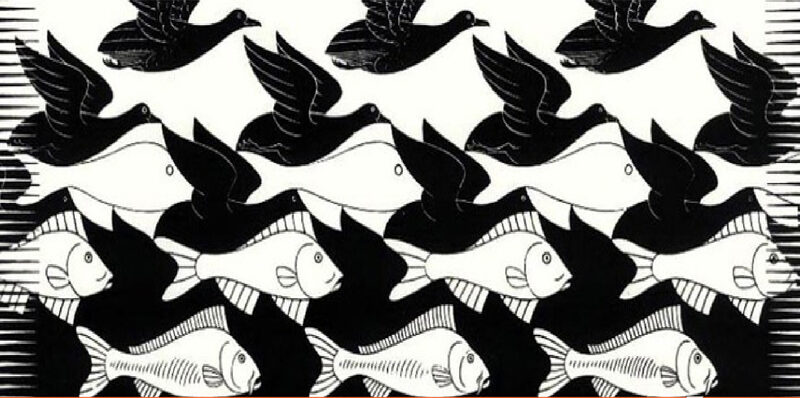As an undergraduate student of psychology, I remember being fascinated by the ideas of Gestalt psychology – principles that describe how meaning mysteriously emerges when we perceive things. Delving more into the nuances of artistic expression, I recognize that some of these ideas have always been used, if not articulated, and have immense value. All visual artists and photographers, anyone working with the visual medium knows about the principle of figure-ground relationship. The classic example is Rubin’s vase (above). In the composition of a visual, to help the viewer create meaning, it is necessary to think as much about the positive space, which is the space occupied by the main figure or vase, as the negative space, which in this case is the white space around. In the example, the relationship between figure and ground is dynamic – that is, it shifts back and forth with equal emphasis on each.
But understanding this relationship and moderating it can lead to myriad expressions. For example, if we wanted to convey loneliness, we might create a very small figure in a very vast field and give a lot of importance to enhancing the experience of the field. Or do the converse if we wanted to convey noise visually. Sometimes, an artist may purposely keep the relationship ambiguous, so we are not sure which is the figure and which is the ground. For example, paintings by M.C. Escher (http://www.mcescher.com/gallery/symmetry/) apply this principle.
But interesting as all this is, how does this help us in management? I am putting down a few ways in which one may find applications for this principle. This is a work in progress. At the end of the article, I would love to know what other applications you can think of!
Positive and negative space in movement
Just as you have figure and ground in the visual medium, you have positive and negative space in movement or the kinaesthetic domain as well. Positive space is the space occupied by you or others, or the space you are moving into. That is the trajectory of your physical progress. The negative space is the space between people, and includes everything other than the “subjects” in the scene. In theatre or dance, we could play with the spaces to create different kinds of effects. In a presentation or a meeting also, we could play with the spaces to create different kinds of effects.
When you consciously manage space, you are helping people around you make meaning out of your actions. For example, defining your stage to be more inclusive or distant depending on the audience you are addressing, moving into negative spaces to create intimacy or impact, projecting or withdrawing your physical presence onto a room. You could use props such as tables, chairs, whiteboards or even a laser pointer to assist in this process. Connecting to the negative space also empowers you with an understanding of the energy in the room and you could either complement it or match it depending on the situation.
Of course, keeping the relationship between figure and ground dynamic or ambiguous in everyday work situations is more difficult as a skill (compared to keeping the relationship stable/clear) and needs practice. But it has huge upsides when you aim to influence thought.
Positive and negative space in conversations
In our auditory sense, as in movement, meaning can be inferred only if there is silence between sounds. Music cannot be without silence between notes and a meaningful speech cannot be without pauses between words. Extend this beyond the purely auditory and into the interpersonal realm. Ever experienced a moment where an extended pause (negative space) proved more powerful than words in a conversation? Then you know what I mean. The more complex a subject, the more negative space needed around it to enable your vis-à-vis to make meaning. Otherwise, to borrow from another Gestalt principle, people will simplify things the way they want to understand them.
In workshops, I find that encouraging participants to use more negative space in conversations (a tough skill in practice, mind you!), can really help add more dimensions to a difficult situation, and thereby open opportunities for solutions. Here too, a more ambiguous figure-ground relationship such as in a negotiation is more difficult to create and maintain than a stable, clear one such as when giving someone instructions. But when you want to make a connection, use of negative space could be an invitation for the other person to step in, and this creates a lot of positivity!
Other applications of positive and negative
The value of zero or a minus sign is self-evident in mathematics, or in interval scales such as used psychometrically. All spiritual good counsel tells us to clear the clutter and create space within to know ourselves better. Which working professional does not know the value of a weekend in a schedule? And which student of human behaviour does not know the value of creating spaces between stimulus and response for greater freedom of choice (ref: the story of Viktor Frankl)? Would we know pleasure without pain?
Tomorrow is Holi – the festival of colour. If everything was green, would we know the colour green? In designing spaces, initiating relationships, in all nature, this appears to be a core principle of creating meaning.
These are just preliminary ideas. Please leave your comments with some thoughts on how you think this concept of positive and negative could be applied to work life. I would welcome different perspectives on this. Meanwhile, enjoy the music, conversations, contrasts and colours of a Happy Holi!
Read it on Linked in – https://www.linkedin.com/pulse/positive-negative-sangeetha-rajan?trk=portfolio_article-card_title
